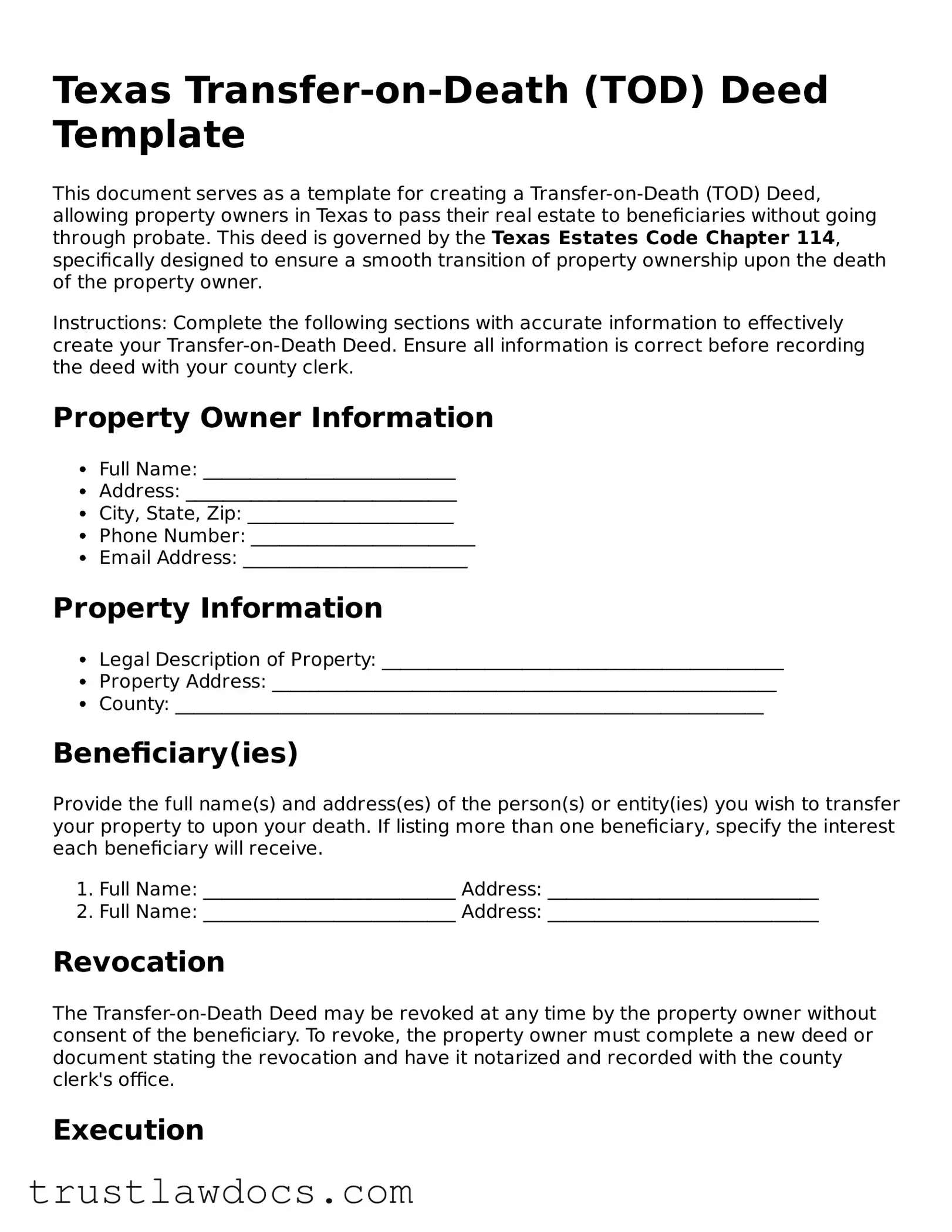The Texas Transfer-on-Death Deed shares similarities with a Last Will and Testament, both serving the crucial role of directing the distribution of assets upon one's passing. Like a Last Will, the Transfer-on-Death Deed allows individuals to specify beneficiaries for their property, ensuring that their wishes are respected without the need for probate court. However, while a Last Will covers a wide range of assets, the Transfer-on-Death Deed is specifically focused on real estate.
Another related document is the Living Trust, which also bypasses the probate process. Individuals can place assets, including real estate, into the trust to be managed by a trustee for the benefit of the designated beneficiaries. The Transfer-on-Death Deed, however, is more straightforward, directly transferring real estate ownership upon death without involving trustees or the ongoing management of a trust.
The Beneficiary Deed, used in some states, is nearly identical to the Texas Transfer-on-Death Deed, allowing property owners to designate beneficiaries for their real estate that will inherit the property automatically upon the owner's death. Both deeds are effective tools for avoiding probate and simplifying the transfer of property, but their availability and specific rules vary by state.
A Joint Tenancy Agreement allows multiple people to own property together with rights of survivorship. This means when one joint tenant dies, their share automatically passes to the surviving joint tenants, similar to the immediate transfer upon death ensured by a Transfer-on-Death Deed. However, joint tenancy involves ownership during the lifetime, unlike the posthumous effect of the Transfer-on-Death Deed.
The Lady Bird Deed, another real estate planning tool, allows property owners to maintain control over their property during their lifetime, including the ability to sell or mortgage, while automatically transferring to a designated beneficiary upon death. Similar to the Transfer-on-Death Deed, it avoids probate, yet it grants the owner more flexibility during their lifetime.
A Revocable Transfer on Death Account (TODA) is a designation used for financial accounts, allowing account holders to name beneficiaries who will receive the assets in the account upon the account holder's death. Just like the Transfer-on-Death Deed for real estate, TODAs avoid probate and allow for a smoother transition of assets, though they apply to financial rather than real property.
The Durable Power of Attorney for Asset Management allows an individual to appoint an agent to make financial decisions on their behalf, potentially including the sale or management of real estate, should they become incapacitated. Unlike the Transfer-on-Death Deed, which is activated by death, this power of attorney can be effective during the owner's lifetime under certain conditions.
The Medical Power of Attorney designates someone to make healthcare decisions on behalf of the individual if they are unable to do so themselves. While not directly related to the transfer of property, it is another important document for end-of-life planning, ensuring individuals' wishes are honored in both health and asset management.
A Life Estate Deed allows the property owner to transfer their property while retaining the right to use and live in the property for the rest of their life. Upon their death, the property automatically passes to the remainderman named in the deed, similar to the Transfer-on-Death Deed's bypassing of probate, though it comes with the limitation of the life tenant’s rights during their lifetime.
Finally, the Gift Deed is a document used to transfer property to another person without consideration or payment. While both the Gift Deed and Transfer-on-Death Deed involve transferring property, the Gift Deed takes effect immediately, unlike the Transfer-on-Death Deed, which only takes effect after the owner's death. Both allow property to change hands, but under different conditions and timings.
